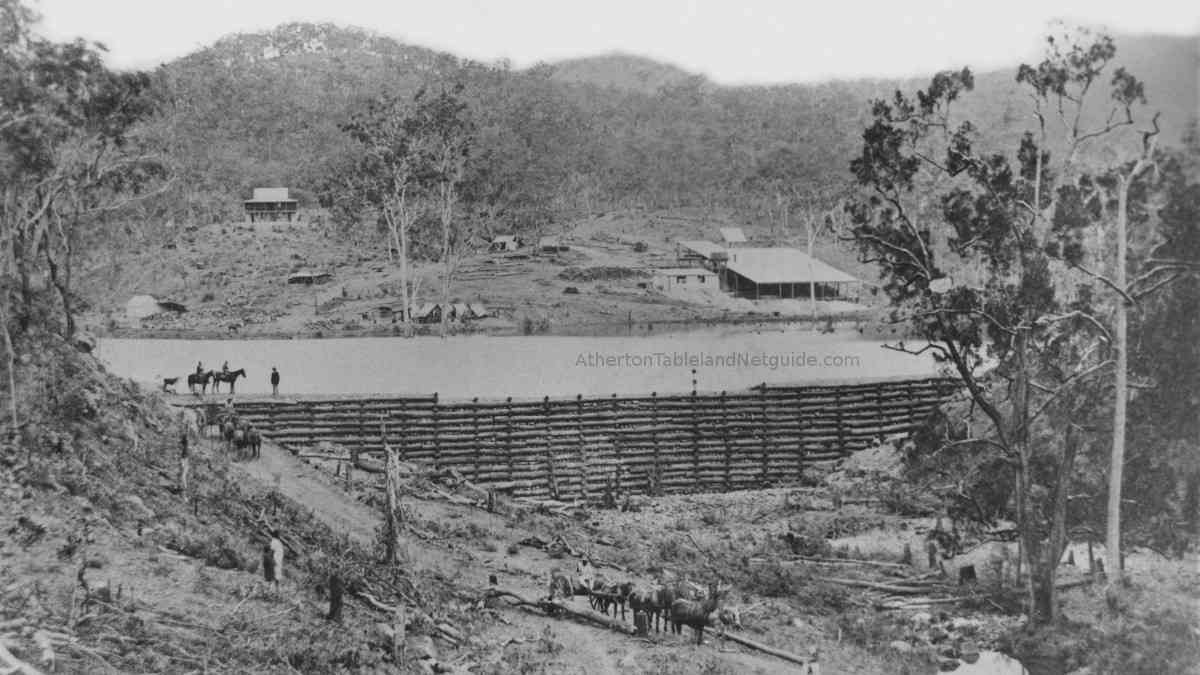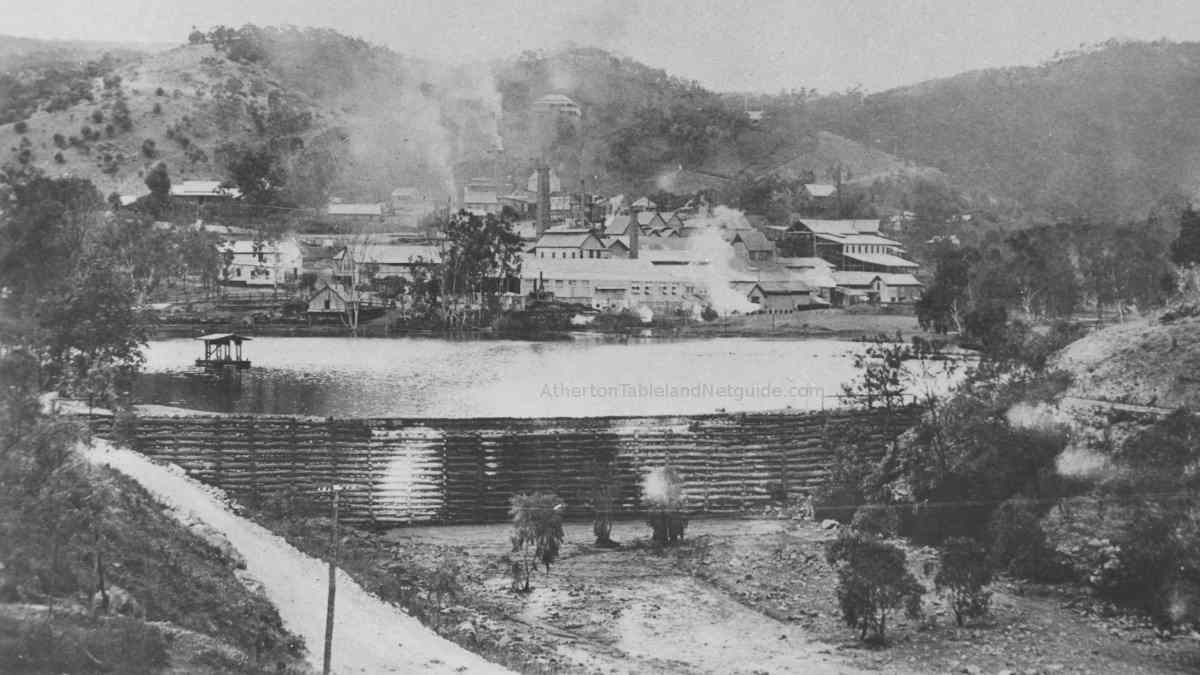

Tropical north Queensland, 1880: Prospectors were beginning to probe the western hills of Australia's Great Dividing Range west of the new ports of Cairns, Port Douglas and Geralton (Innisfail). Rich lodes of tin, copper, silver-lead and deposits of silver and gold drew people from far flung corners of the world in search of fortunes, jobs, and new opportunities.
In 1882, a party of miners led by James Gibbs discovered and claimed seven tin lodes around 15 miles west of Herberton. The rich ore was easily accessible and assayed up to 60% pure tin. However, with no crushing facilities in such a remote location, Gibbs and party happily sold the mines for the princely sum of £6,000 to the Glen Smelting company, who already had tin batteries set up at Watsonville and Herberton.
In 1883, John Moffat, director of the Glen Smelting Company, decided to make "Gibb's Camp" his north Queensland home and headquarters. Moffat renamed the place 'Irvinebank' in memory of his birthplace, Newmilnes, situated on the banks of the River Irvine, in Ayrshire, south-west Scotland.
In 1884, Moffat had a dam, a treatment plant, and a small smelter built to process ore from his own mines, and those of independent miners. Moffat built Loudoun House and named the works 'Loudoun Mill', after the mill on the River Irvine. Loudoun was also the name of the parish in which he was born, and his mother's maiden name.
The dam, which formed a small lake in the middle of the arid hills, was also christened Loudoun Dam.

A small town quickly sprung up in the little valley and hillslopes around the lake, housing the workers at the mill and company mines, and also the families of independent miners. Storekeepers, teamsters, blacksmiths, woodcutters: occupations representing all walks of life creating a community isolated in the hills, far away from the cities of the more populated south east of Australia. In the first year, Irvinebank had a population of around 150 people, with a baker, a butcher, at least two hotels, a drapers, two churches (Catholic and Methodist), and a School of Arts hall.
In 1885, a post office opened, and in the following year, a school. By 1891, the population numbered 250.
In 1889, the Vulcan lode was discovered by a party of italian woodcutters. The party sold their interests to a local syndicate who floated the company and attempted to prevent Moffat's investment in order to prevent his monopoly over the field. But John Moffat purchased shares by proxy, and gained control of the company within 6 months.
The Vulcan became the richest and deepest tin mine in Australia and was the mainstay of Irvinebank's economy for more than 30 years.
By 1901, the population of the town had grown to 619, and 10 years later it had doubled to more than 1,200.
In 1907, a narrow-guage tramway connected Irvinebank to the railway line at Boonmoo. For the first time, Irvinebank was mentioned in a tourist guide - Handbook to Cairns and its Hinterland published by Queensland Railways in 1910. "Passengers by, the 7 a.m. train from Cairns on Mondays, Wednesdays, and Fridays connect with train leaving Boonmoo at 1.40 p.m. for Stannary Hills, arriving Stannary Hills 3.10 p.m. and Irvinebank at 5 p.m., leaving irvinebank at 8.30 a.m., Stannary Hills 10.30, and connecting with' train at Boonmoo for Cairns 011 Tuesdays, Thursdays, and Saturdays, reaching Cairns at 5.50 p.m."

Around the picturesque town of Irvinebank are many small mines ; in consequence of their inaccessibility in some cases, the ore is transported to the mill on pack animals, mules being found the most suitable for this purpose ; some of these animals will carry as much as 300 pounds.Handbook to Cairns and its Hinterland, Queensland Railways, 1910.
The coming of the tramway was a boon for residents of the isolated town. An estimated 1,500 people boarded the trains for a celebratory picnic at picnic flat, and picnic trains became a regular feature of the community's recreation.
After 1912, declining tin prices, a depressed economy, and the lack of labour due to World War I saw the population rapidly decline.

While a small population remained, by the mid-twentieth century, Irvinebank had become a virtual ghost town. In his 1969 book, Along the Great Divide, Australian travel writer, William Alfred (Bill) Beatty, describes a visit to Irvinebank:
The main street of Irvinebank is lined with deserted two storeyed buildings of brick and decaying wood, with shutters falling off their rusted hinges. A conspicuous structure is the School of Arts Hall whose interior reveals a large dance-floor and a fine stage; a pathetic sight being the tattered drop curtains and the torn, faded scenery. Handbills on the musty walls advertise the visit of theatrical companies of bygone days. It is even more depressing to see the once well-stocked library of more than two thousand books all mouldering into dust; they crumble at the mere touch. Outside the School of Arts Hall there used to be a large lawn where musical programmes were regularly given by the town’s two brass bands, the winners of many a North Queensland band contest and music festival.
During the peak of Irvinebank's development, and that of other mining communities in the area, secondary industries grew to service the needs of the workers of the outback mineral fields. Demand for food for the people and for the animals which were such an important part of the economics of transport, stimulated the development of agriculture on the Atherton and Evelyn Tablelands.
Ports developed on the coasts to serve the needs of the inland population. Port Douglas and the nascent Cairns competed with each other to provide the best road links and lobbied government and private industry to build railways and transport infrastructure.
In the early years of Irvinebank's development, Port Douglas was the main coastal port, but when Cairns won the right to be the railway terminus for Herberton, it won the race to become the 'capital' of the tropical north.

The mining communities of the arid and rocky wild ranges required good timber for building works and housing. John Moffat bought land at Cedar Creek and built a timber mill. He had some land cleared for raising bullocks for his transport teams, but was also an exponent of selective logging and loathed to see the magnificent forests clear felled for agriculture. The timber and bullock camp at Cedar Creek became the township of Ravenshoe.
The wealth generated from the Vulcan and other Irvinebank enterprises was invested in developments south, west and north, at Mt Garnet, Chillagoe, Wolfram Camp and points everywhere in between. This region became known as 'John Moffat's Empire'.
Moffat retired from the industry in 1912, at the age of 71. Forced out under threat of liquidation and accused of running his enterprise as a 'benevolent asylum'. He left Irvinebank under the management of his business partner, John Holmes Reid, and moved to his home and offices at Cremorne, New South Wales.
The indefatigable entrepeneur continued to work promoting the Moffat-Virtue agricultural machinery that he had helped to develop during his lifetime, including the Moffat-Virtue petrol-kerosene engine and some of the earliest mechanised sheep - shearing equipment in Australia.
John Moffat died in Toowoomba, Queensland on June 26, 1918, of a heart attack, at the age of 78. Some sources attributed his death to the dreaded Spanish Flu.
Working conditions on the northern mining fields were dangerous, unhealthy and poorly paid. The Vulcan Mine was no exception. It was well known for its accidents and by 1907 the workers remained unorganised and unrepresented.
It was in this year that Edward Granville Theodore began work at the mine. Some collapsing timbers fell on his back and he carried the scars throughout his life.
In September of that year, Theodore helped to organise the workers into what became known as the Amalgamated Workers Association (AWA).
The 'fighting' AWA, as it be came known, was the first successful workers organisation in north Queensland and grew to encompass workers from all over the region in almost every industry.
The AWA also propelled Theodore into a life of politics that was to see him become treasurer of the State of Queensland, Premier and then Federal Treasurer.
The State Government, with Theodore as Treasurer bought the assets of Moffat's company and brought Loudoun Mill back into operation to serve the needs of the independent miners of the area. The mill became known as the State Treatment Works and remained in State ownership until the 1980s.
The last crushing of tin ore occurred in the early 1990s and today the stampers remain quiet. Today Irvinebank contains many relics of its past. The townscape is one of only two to have Heritage listing in Queensland (the other is Ravenswood).
Mike O'Callaghan's History of Irvinebank
Irvinebank's surgeon and astronomer Dr William McFarlane
John Moffat of Queensland by Randolph Bedford
John Moffat of Irvinebank, by Hugh Borland
Fatal Explosion at the Australian Hotel, Irvinebank
If you enjoyed reading this page, please show your support and tip the author the price of a coffee or beer: